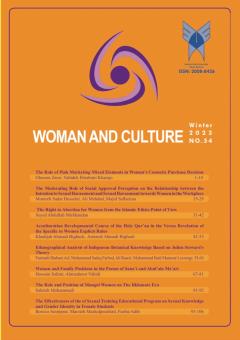Women and Family Positions in the Poems of Sana'i and Abul'ala Ma'ari
Subject Areas : Persian the literatureHosein Salimi 1 * , Ahmadnoor Vahidi 2
1 - Assistant Professor, Department of Persian Language and Literature, Faculty of Literature and Humanities, Persian Gulf University, Bushehr, Iran.
2 - Assistant Professor, Department of Persian Language and Literature, Faculty of Literature and Humanities, Higher Educational Complex of Saravan, Saravan, Iran.
Keywords: Women and family positions, Poetry works Ma’ari, Poetry works of Sana'I,
Abstract :
The research was intended to investigate the women and family positions in the poems of Sana'i and Abul'ala Ma'ari. The study statistical universe encompassed the poetry works of Sana'i and Abul'ala Ma'ari. The sample of the research subsumed the selected verses from the poems of Sanai and Abul Ala Maari which were selected based on their positive and negative views on the position of women and family. The research was designed with descriptive- analytical method. To analyze and compare the views of two poets on the subject, a sample of the both poets' poems were discussed and analyzed The results indicated that Sanai and Abul Alaa Maari were two famous poets in Persian and Arabic literature who explained and analyzed the position of women more than others. At the same time, there were similar cases in their worldview towards women and the foundation of the family, as well as differences in their thoughts. According to Sana'i point of views, sometimes social poems about women and family were subject to emotions. On the other hand, Maari's thoughts about women and family were not only caused by fleeting feelings, but had been influenced by a kind of deep philosophical despair and pessimism, which had developed in him over many years. Another point was that many of Maari and Sana's comments and insights towards women were influenced by the society and social conditions of their era. And this was more true about Senai. In other words, many of the popular beliefs and opinions of the society about women and family had been effective in the mind and language of these two poets.
The Holy Quran.
Afrasiabpour, A. (2001). The authority of women and Hazrat Zahra (PBUH), from the perspective of the Ghaznavid Sana'i. Journal of Women and Culture, 2(6), 93-106. URL: https://jwc.ahvaz.iau.ir/article_523390.html
Bagheri, Kh. (2003). Philosophical foundations of feminism. Tehran: Office of Social Planning and Cultural Studies of the Ministry of Science, Research and Technology. URL: https://www.gisoom.com/book/1262268
Bahmani Mutlaq, Y., & Sharbat A. (2012). The position of women in Islamic mysticism and Sufism (Relying on the works of Sanai, Attar and Jam. Journal of Women and Culture, 3(10), 70-53. URL: https://jwc.ahvaz.iau.ir/article_523318_da156faa75f9559a7512d969b86c8aa4.pdf
Bakhtiar, M. (2009). Spiritual position of women in Islamic mysticism. Journal of Women and Culture, 11(44), 17-27. ]Persian[ URL: http://ensani.ir/file/download/article/1602059554-10314-99-264.pdf
Dadkhah, H, Golizadeh, P,. & Nazarpour, B. (2012). The position of women from the point of view of modern writers of Masrnovin, research paper on women, research institute of humanities and cultural studies, fourth year. Second Issue, 1(2), 73-83. URL: https://womenstudy.ihcs.ac.ir/article_1073_107e7ce0a3877c4d8fe883202fa7c8ff.pdf
Fatorehchi, M. (2005). The Society of Society in Sanai Works, Tehran: Amirkabir. ]Persian[. URL: https://www.gisoom.com/book/130869
Foroukh, O. (1963). Philosophical Beliefs of Abul Ala. Translated by Hossein Khadio Jam. (2001). Tehran: Pocket Books Organization. ]Persian[.URL: https://www.gisoom.com/book/11141420
Hosseini, M. (2004). The roots of feminism in classical Persian literature. Tehran: Amirkabir. ]Persian[ URL: https://www.gisoom.com/book/1620032
Javad, A. (1976). The detailed in the history of literature in pre-Islamic times. Beirut: Dar for the Science of Millions. ]Persian[ URL: https://www.noor-book.com/en/ebook.
Karimi, A. (2015). Criticism and review of the pessimistic philosophy of Sheikh Maara. New Religious Thought Quarterly, 11(42), 139-154.]Persian[ URL: http://andishe.maaref.ac.ir/article-1-296-fa.html
Ma'ari, A. A. S. (1999). Message Alghafran, Explanation and presentation of Salim Majaes. Tehran: Awaken to the distribution Shenro. ]Persian[ URL: https://ketabpedia.com
Ma'ari, A. A. S. (2000). The court of the necessity of Malaysia (Requirements). Beirut: Dar Al-Arqam Publishing House Ibn Abi Al-Arqam. URL: https://www.goodreads.com/book/show/53168587
Ma'ari, A. A. S. (2004). Divan Luzum Mala Yalzam. Beirut: Publisher of the Arabic Library. URL: https://lib.ui.ac.ir/inventory/1/48027.htm
Mirzai, P., & Gharavi Nayini, N. (2015). A new approach to the hadith "Dafn al-Banat Man Al Makramat. Hadith Sciences, 20(2), 120-136. ]Persian[ URL: http://hadith.riqh.ac.ir/article_12249_22e06c19e09205f4b247820c6b3a548c.pdf.
Naser Khosrow, A. N. (1991). Safarnameh. Tehran: Zavar. ]Persian[ URL: https://eliteraturebook.com/books/view/12961
Nasr, Z. (2003). An analysis of the place and position of women in lyrical, didactic and mystical systems. Scientific Research Journal of Faculty of Literature and Human Sciences, University of Isfahan, 2(32-33), 169-187. http://ensani.ir/file/download/article/20110208143822-%C2%A0%20(249).pdf
Noorian, M., Toghiani, E., & Saeed, H. (2005). Thematic sociology of Sana'i works. Exploration of Persian Language and Literature, 6(10), 63-92. URL: https://www.sid.ir/paper/101581/fa
Razazzadeh, Z., Haji Esmaili, M.R., & Mosleh, M. (2019). Formation of a woman's rational personality from the perspective of the Qur'an and Hadith. Journal of Women and Culture, 11(44), 17-27. URL: https://jwc.ahvaz.iau.ir/article_675195_4664572d0bdeb30e7be70d7486a460ac.pdf
Sajjadi, Z. (2006). An Introduction to Mysticism and Sufism. Tehran: Samt. URL: https://samt.ac.ir/fa/book/1651
Sanai, A. M. I. A. (2009). Divan Sanai. Tehran: Sanai Library Publications. ]Persian[ URL: https://eliteraturebook.com/authors/books/5501
Sanai, A. M. I. A. (1975). Divan Sanai. Tehran: Sanai Library Publications. ]Persian[ URL: https://eliteraturebook.com/authors/books/5501
Seyedi, H., & Adinekalat, F. (2018). Comparative study of the concept of death in the thought of Abul Ala Maari and Omar Khayyam Neishaburi. Journal of Comparative Literature, 1(2), 117-137. ]Persian[. URL: https://www.noormags.ir/view/fa/articlepage/596706
Shamisa, S. (2002). Witnessing in Persian Literature. Tehran: Ferdos Publications. ]Persian[ URL: https://joyabook.com/product//
Sharifiyan, M. (2010). Sociology of mystical Sana'i literature. Sociology of Irfan Senai literature, 1(2), 11-27. URL: https://www.sid.ir/paper/213713/fa
Zakavati Gharagozlou, A. (2016). A brief overview of the state and thought of Abul Ala Ma'ari. The Mirror of Research, 28(4), 13-22. URL: https://jap.isca.ac.ir/article_65230_23afb1d5b52ee90920f6317fc83c4ca3.pdf
Zarin Koob, A. H. (2007). With the Helle Caravan. Tehran: Scientific Publications. URL: http://elmipublications.com/product/bakarevaneholle
_||_
